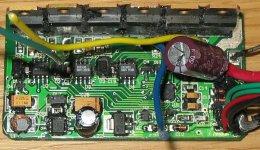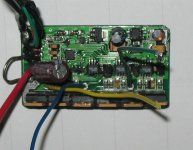Jeremy Harris
100 MW
I've bought one of the surplus TongXin motors and controllers from Justin at ebike.ca to play with (please don't hit me with all the reasons why the TongXin stuff is bad - I've already read it all........).
What puzzles me is the way that the controller starts the motor from a standstill, as it doesn't have any Hall sensors, just the three phase wires to the motor. It must work the same way as the RC model motor controllers, I guess, but having read all the threads on here relating to sensorless controllers I am still not sure. The motor isn't a "pedal first" type, as it has a freewheel, so it can't be spun up to speed before applying power.
My interest lies in looking for a possible substitute controller, maybe using a RC model type or perhaps building one from scratch as a project. The existing controller is potted in resin and looks pretty near impossible to reverse engineer without destroying it.
Has anyone ever tried to get inside one of these controllers to figure out how they start up? Any clues would be useful.
Jeremy
What puzzles me is the way that the controller starts the motor from a standstill, as it doesn't have any Hall sensors, just the three phase wires to the motor. It must work the same way as the RC model motor controllers, I guess, but having read all the threads on here relating to sensorless controllers I am still not sure. The motor isn't a "pedal first" type, as it has a freewheel, so it can't be spun up to speed before applying power.
My interest lies in looking for a possible substitute controller, maybe using a RC model type or perhaps building one from scratch as a project. The existing controller is potted in resin and looks pretty near impossible to reverse engineer without destroying it.
Has anyone ever tried to get inside one of these controllers to figure out how they start up? Any clues would be useful.
Jeremy





